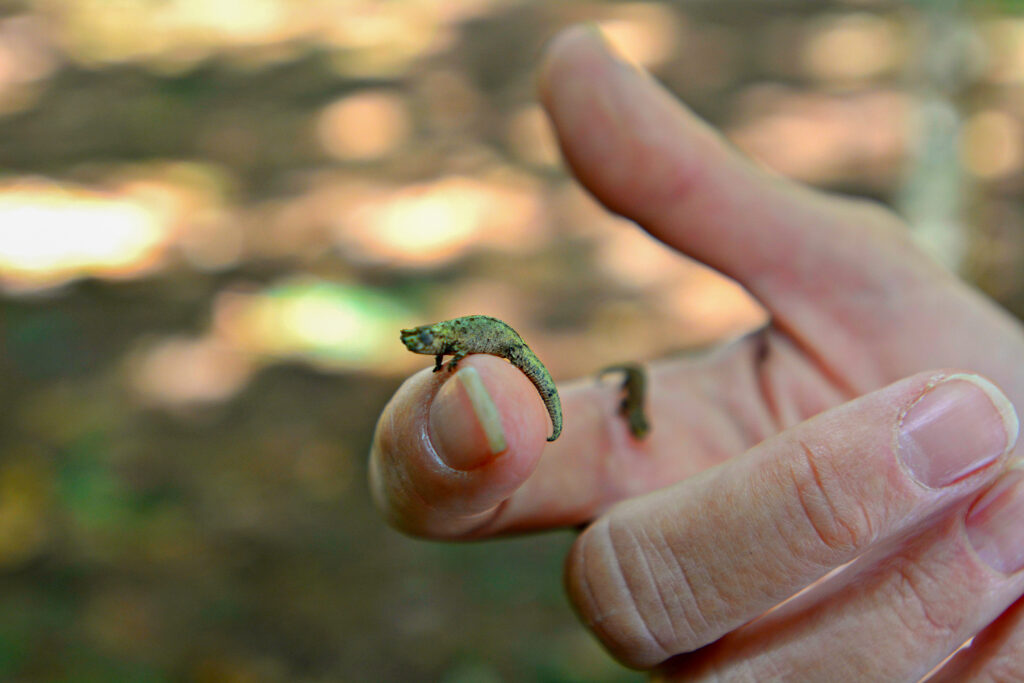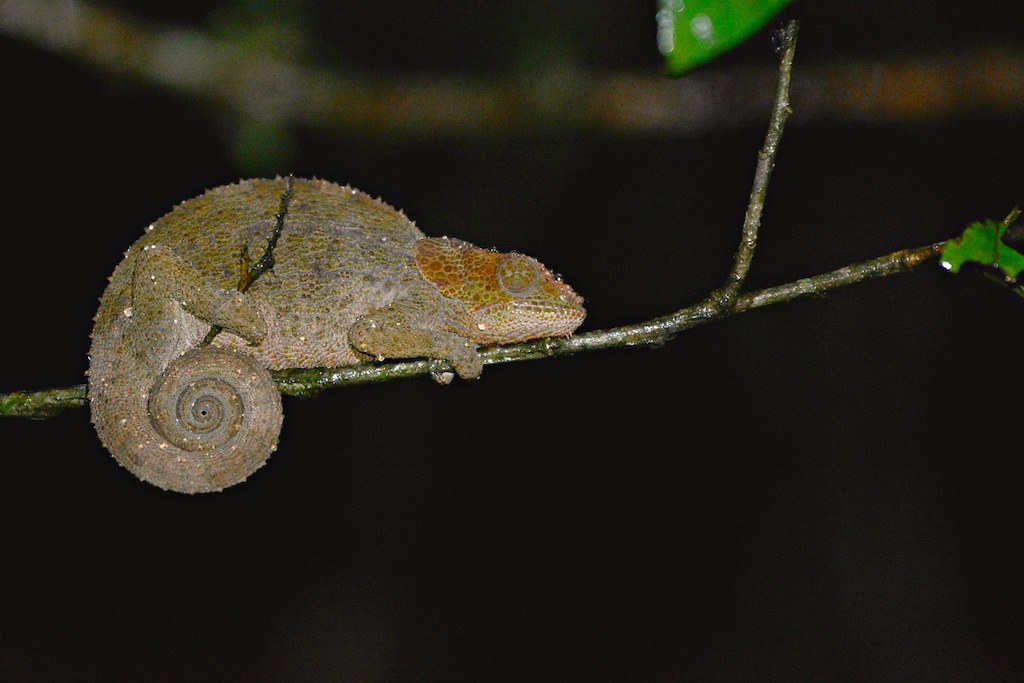Hanging in the hallway outside my room here at Centre ValBio (CVB) is an embroidered depiction of the nine, yes nine species of chameleons that occur in Ranomafana National Park. I’ve been lucky enough to see a handful of them, mostly at night, with a couple species seen during the day.

Almost half of all chameleon species, including the biggest and the smallest in the world, are endemic to Madagascar. Chameleons are lizards that display a number of features to adapt to a mostly arboreal (in the trees) lifestyle. Their hands are converted into tong-like climbing instruments – two lateral fingers oppose three inner fingers with the structure reversed on their feet – two inner toes and three lateral toes. Their prehensile tail is like a 5th appendage, able to grasp onto twigs or when relaxed, it’s curled into a snail-like shape.
When not disturbed chameleons move very slowly and in a rocking motion, making it difficult for predators, such as birds, to discern them among the dense vegetation. Chameleons are well known for their ability to move each eye independently and thus thoroughly scan the surrounding environment.
When stalking prey both eyes are focused forward. With their projectile, long, sticky tongue they can capture prey beyond their body length. Chameleons are active during the day and at night roost at the end of branches or leaves. This allows them to detect vibrations that warn of an approaching predator, such as a snake.
Chameleons live solitary lives except during the breeding season. In contrast to some African chameleons, those on Madagascar are oviparous (egg laying). Intraspecific (within species) competition can be fierce. If two males come in visual contact they will change color immediately, likely a function more as an optic language than imitating the color of their background.
There are 3 chameleon genera in Madagascar – Brookesia, Calumma, and Furcifer. Below I’ve gone though those I’ve recorded in Ranomafana National Park and in other sites in my travels around the island.
Parson’s chameleon (Calumma parsonii) is the largest species of chameleon. The males can get up to 27 inches long and display a prominent nose crest. The female dig a hole 12 inches deep and lay up to 35 eggs. Their incubation need is complex, requiring alternating warm and cold periods. Juveniles hatch after 400-520 days! Their live span in the wild is up to 12 years. The species does well in disturbed forest and is generally not found in pristine forest.
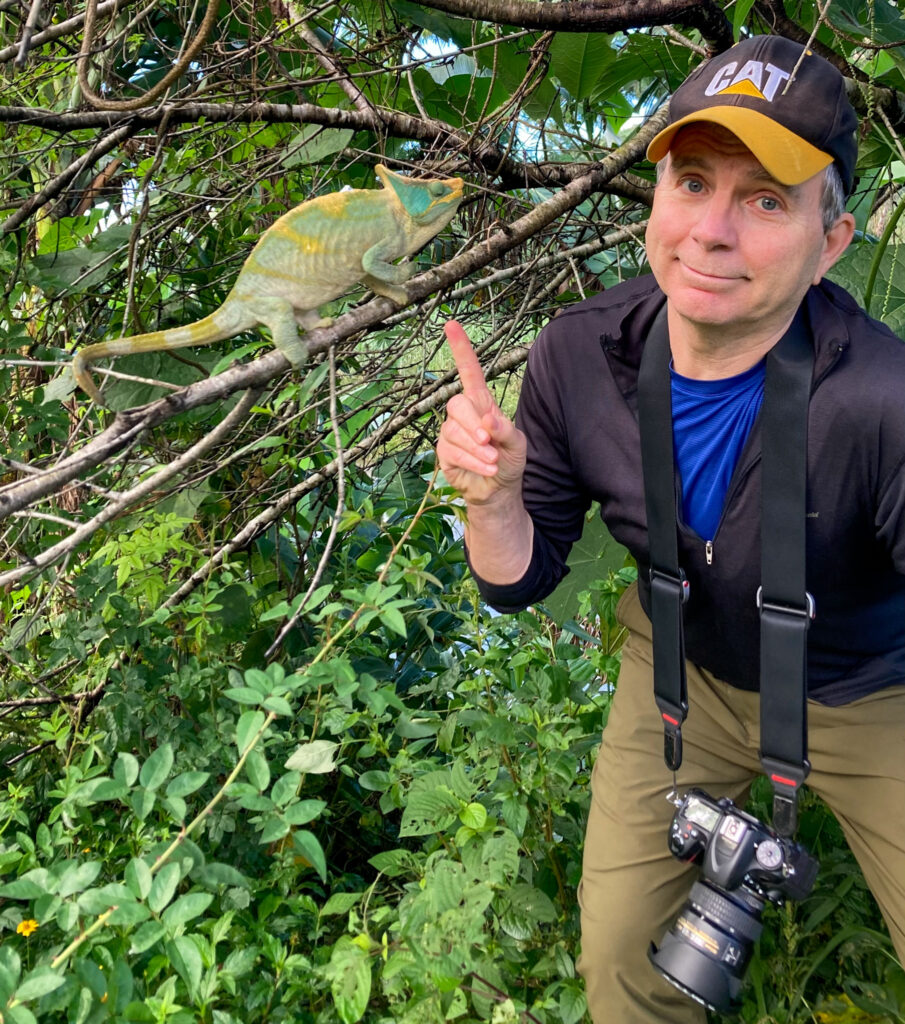
The cryptic (blue-legged) chameleon (Calumma crypticum) Is often colorful, marked with blue, green, and deep brown. It often has blue markings on its legs. This is a common species in mid-elevation and montane humid forests from 3,500 – 6,000 ft elevation.
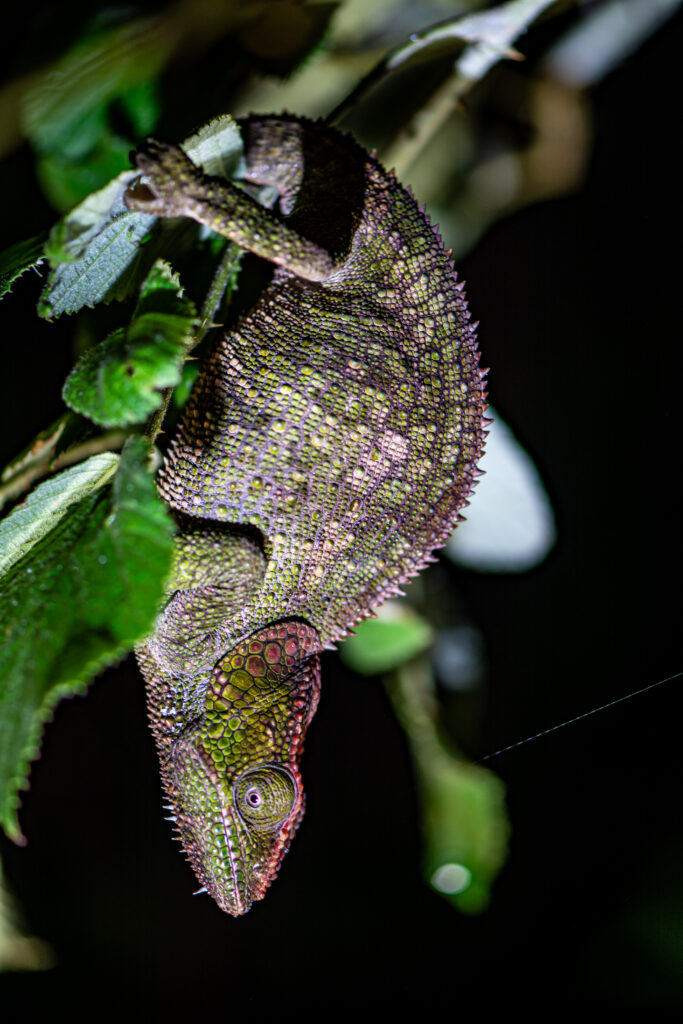
O’Shaughness’ys chameleon is commonly found in the rainforests of southeast Madagascar. Males can get up to 15 inches long with a prominent nose crest. They often have a turquoise band along the lower lip, but this is variable. Activity increases through the morning and peaks in mid-afternoon before seeking and evening roost.

The panther chameleon (Furcifer pardalis) is found in a variety of habitats in the northern third of Madagascar. It is a common occupant of dry forest and does well in disturbed forest. Males grow up to 20 inches in length with a pair of nose crests joined at the tip. Color can vary from deep green to almost total red. It is found in primary forest but is more common in secondary forest.
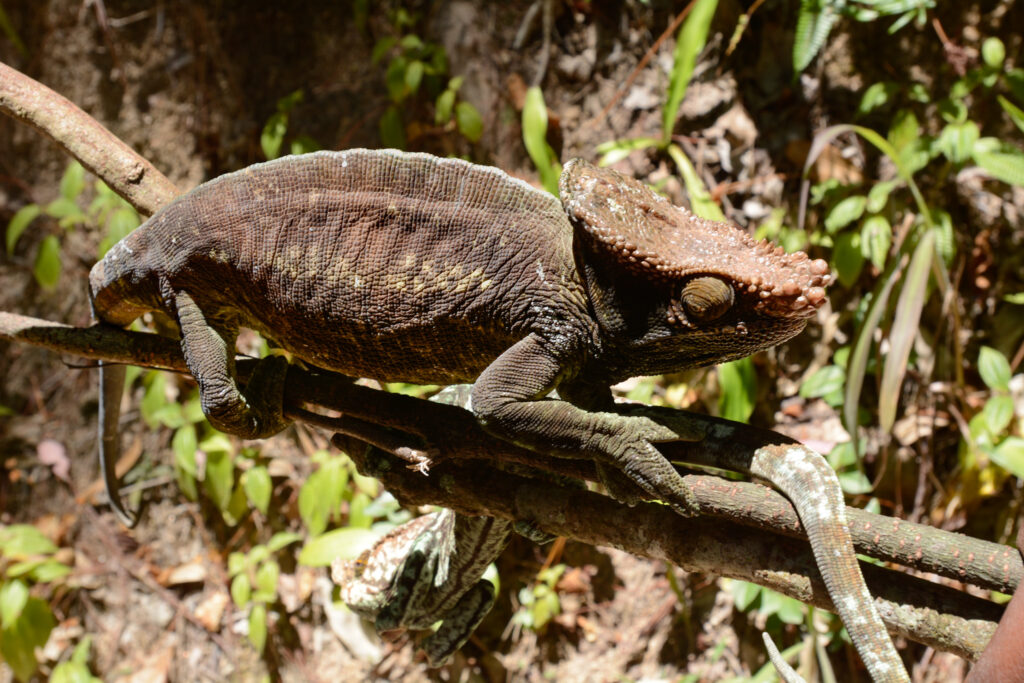
The jeweled chameleon (Furcifer lateralis) is one of my favorites. It’s a bit smaller, growing to 12 inches long. But the charm for me is its side color pattern. Both sexes display a pale line with 3 dark circles along the sides. It is found in a variety of habitats including montane wet Savannah, deciduous dry forest, arid spiny forests, and tropical rainforest. In captivity they have lived 2-3 years.

The Petter’s Chameleon (Furcifer petteri) is a strange looking fellow, males display 2 large horns on the end of their nose. They color is green or yellow green, with males growing to about 6.5 inches long. It can be found in pristine primary forest, subhumid forest, and in degraded habitats.
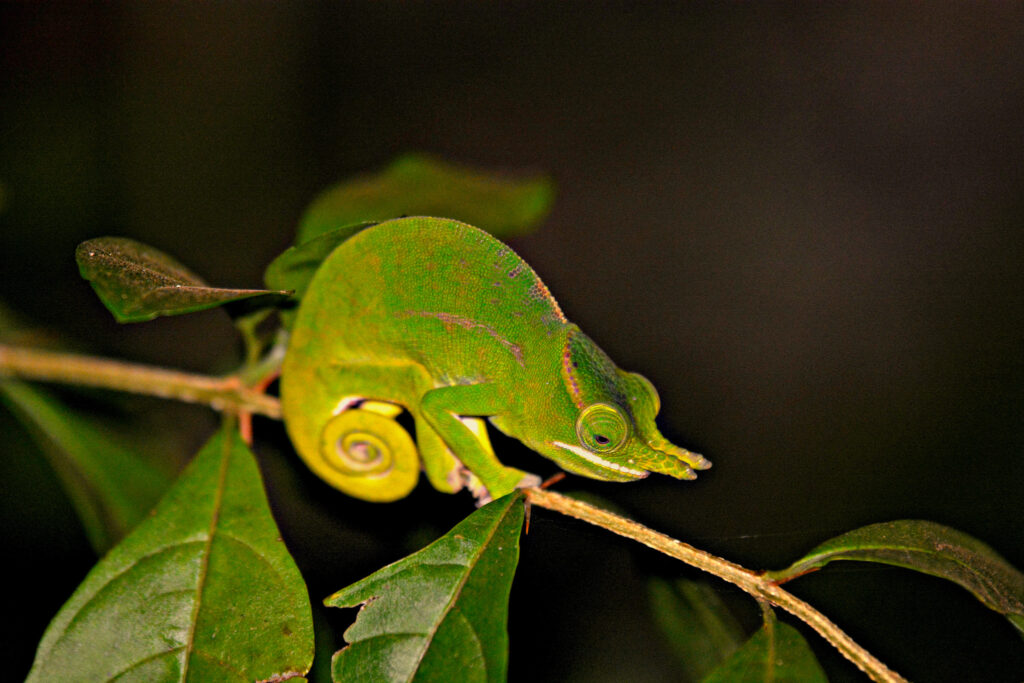
Oustalet’s chameleon (Furcifer oustaleti) occurs throughout the island except the interior of the eastern rainforest. It seems to do quite well in disturbed forests. The species is easily identified by the rounded, helmet-like projection (casque) on the back of the male’s head. The grow up to 27 inches in length. And yea, this species drew blood from me. We were driving back from a forest hike and one was crossing the road. We stopped and while my guide said “…no, no, no,” I tried to pick him up. He latched onto my finger and I obliged and dropped him. Then our guide got a stick and showed me the proper way – tipping the stick to the chameleon as he easily climbed aboard. On the drive back as I sucked on my bloody finger our guide noted “Well, a souvenir from Madagascar!”. Lesson learned.

The big nose chameleon (Calumma nasutum) is widespread in the eastern rainforest and forest edge. These are small guys that grow up to 4 inches or so. It’s widely distributed and common. I’ve found numerous individuals of this species while searching at night in low vegetation with a headlamp.

The blue-nosed chameleon (Calumma boettgeri) is similar to the big nose chameleon but distinguished by its blue rostral crest that is typically gray or turquoise. It often displays a horizontal stripe on each side of the head, passing through the eyelids. It’s a common species of secondary forest.
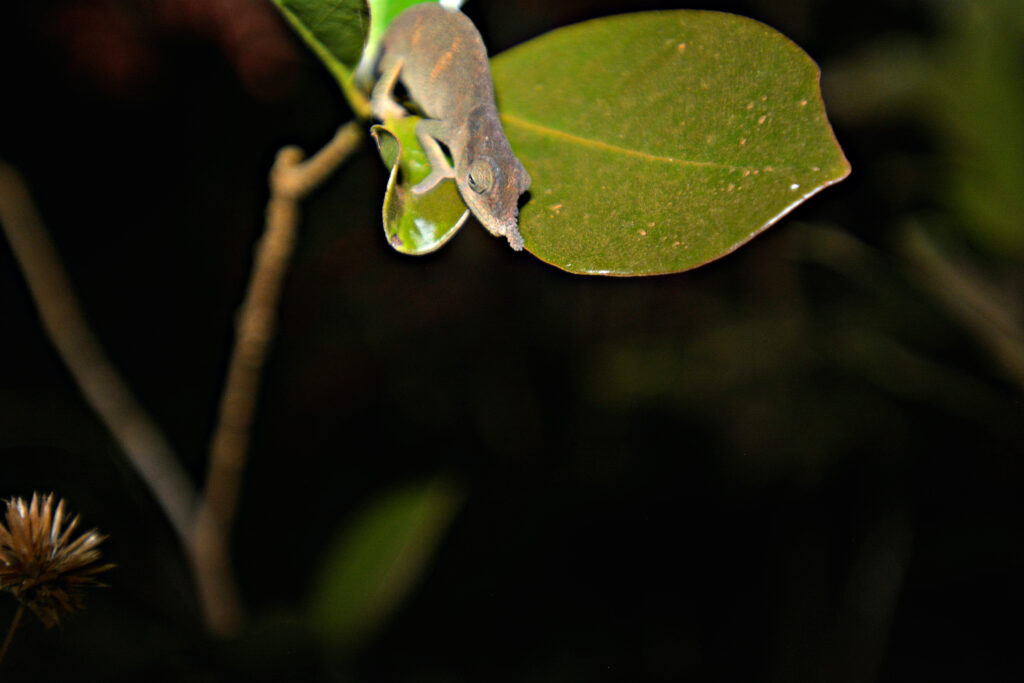
The lance-nosed chameleon (Calumma gallus) is aptly named. The males sport a quite long and point rostral crest that is quite distinct. It has a low profile casque. It’s another small (up to 4.5 inches in length) chameleon of mid-elevation forests.

The perinet chameleon (Calumma gastrotaenia) is common in rainforest from central to southern Madagascar. It’s small, growing to just 5.5 inches. It’s uniformly green and males have a distinct white lateral band on their sides. Found in both primary and secondary forest.

The Montaigne d’Ambre Leaf Chameleon (Brookesia tuberculata) is among the world’s smallest vertebrates. The Brookesia genus includes seven of these tiny leaf chameleons that are typically found during the day in the leaf litter and 3-4 feet high in shrubs during the evening. At Ranomafana we found a couple B. superciliaris – the brown leaf chameleon, in a shrub during the day. Apparently when the ground is too wet they will climb into nearby shrubs during the day. The adult tuberculata grows to just 1.5 inches. I found these, or more correctly our guide found these on Amber Mountain on the northern tip of the island after a half hour or so on our knees grubbing around carefully in the leaf litter.
